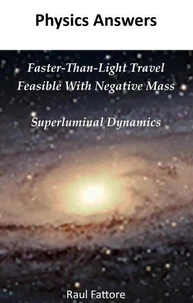Nuclear Fusion Enhanced by Negative Mass – A Proposed Method and Device – (Part 2). Nuclear Fusion Enhanced by Negative Mass, #2
Par :Formats :
Disponible dans votre compte client Decitre ou Furet du Nord dès validation de votre commande. Le format ePub est :
- Compatible avec une lecture sur My Vivlio (smartphone, tablette, ordinateur)
- Compatible avec une lecture sur liseuses Vivlio
- Pour les liseuses autres que Vivlio, vous devez utiliser le logiciel Adobe Digital Edition. Non compatible avec la lecture sur les liseuses Kindle, Remarkable et Sony
 , qui est-ce ?
, qui est-ce ?Notre partenaire de plateforme de lecture numérique où vous retrouverez l'ensemble de vos ebooks gratuitement
Pour en savoir plus sur nos ebooks, consultez notre aide en ligne ici
- FormatePub
- ISBN8227337290
- EAN9798227337290
- Date de parution27/05/2024
- Protection num.pas de protection
- Infos supplémentairesepub
- ÉditeurBig Dog Books, LLC
Résumé
The Universal Force provides a superior method for calculating total energy for a system of charges, including kinetic variables like velocity and acceleration. This formula is absent in Relativity Theory and other theories. The relationship between force and total energy is demonstrated for zero-force, zero-energy, maximum force, and maximum energy. The interaction distance between single charges, nuclei, atoms, or molecules is dynamic and depends on system kinetics, contradicting the "Van Der Waals radii" assigned to elements in the periodic table.
The Universal Force provides a superior method for calculating total energy for a system of charges, including kinetic variables like velocity and acceleration. This formula is absent in Relativity Theory and other theories. The relationship between force and total energy is demonstrated for zero-force, zero-energy, maximum force, and maximum energy. The interaction distance between single charges, nuclei, atoms, or molecules is dynamic and depends on system kinetics, contradicting the "Van Der Waals radii" assigned to elements in the periodic table.



















